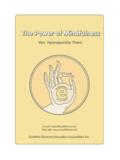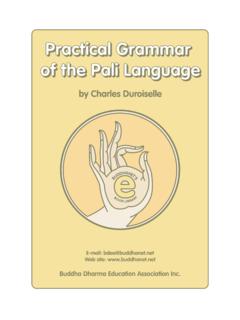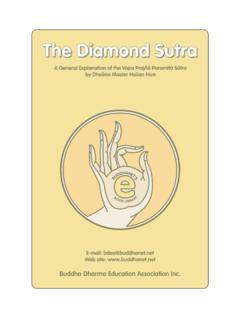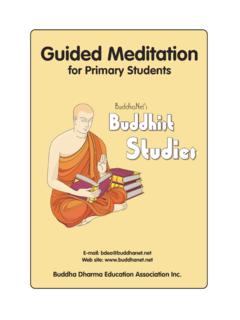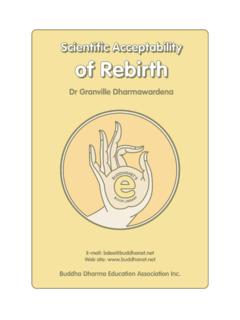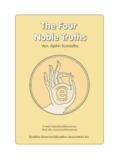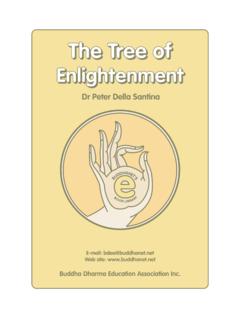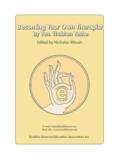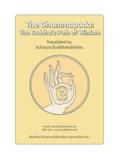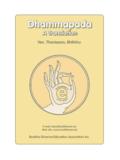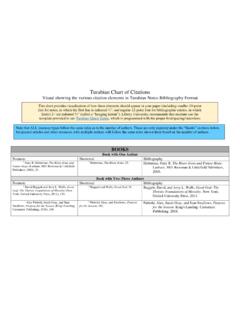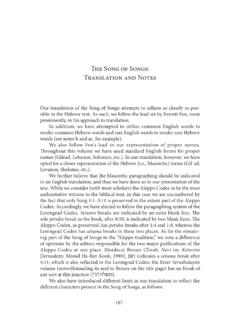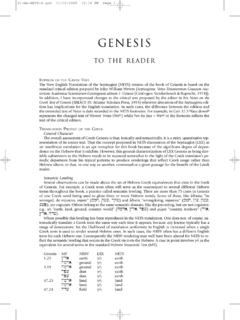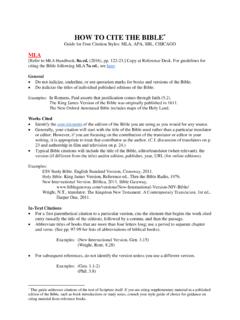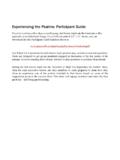Transcription of By Narada Maha Thera - Buddhism
1 EBUDDHANET'SBOOKLIBRARYE-mail: site: Dharma Education Association Narada Maha TheraA Manual of Abhidhamma(Abhidhammattha Sangaha)A Manual of Abhidhamma(Abhidhammattha Sangaha)A Manual of AbhidhammaBeingAbhidhammattha Sa gahaofBhadanta Anuruddh cariyaEdited In TheOriginal P li Text With EnglishTranslation And Explanatory NotesBy N rada Mah Thera ,Published By the Buddhist Missionary Society,123, off Jalan Berhala, 50470 Kuala Lumpur, of the Buddhist Missionary Society, First edition 1956 Second revised edition 1968 Third revised edition 1975 Fourth revised edition 1979 All rights reservedFifth Edition published by the Buddhist Missionary Society. ISBN 967 9920 42 9 (1987)iiiAbout this bookAbhidhamma is the Higher Teaching of the Buddha, some-times referred to as the ultimate teaching (paramatthadesan ).
2 In it, man is described as a psycho-physical beingconsisting of both mind and matter, and it gives a micro-scopic analysis of the human explains the process of birth and deathin detail. In addition to defining consciousness, it alsoanalyses and classifies thoughts mainly from an ethicalstandpoint. Various types of consciousness are also setforth in detail, as they arise through the six psychology has begun to acknowledge that itcomes within the scope of Abhidhamma for the reason thatit deals with the mind, with thoughts, thought-processes,and mental states. Buddhism has, from the very beginning,taught psychology without a also helps the student of Buddhism tofully comprehend the Anatta (No-Soul) doctrine whichforms the crux of Buddhism .
3 To a person who reads thisbook in a superficial manner, Abhidhamma appears as dryas dust, but to the wise truth-seekers, it is an indispensableguide as well as an intellectual treat. The reader who readsthis book with deep thinking cannot fail to find it withplenty of food for thought and which will help him tremen-dously to increase his wisdom so essential for leading anideal Buddhist way of life, and the realization of UltimateTruth, Nibb Author, the late Venerable N rada Mah Thera ,was a well-known Buddhist Missionary from Sri Lankawho had written many valuable Buddhist publications,among which is A Manual of Buddhism , a grasp of whichis imperative prior to the reader commencing his study of A Manual of Abhidhamma.
4 Cover design by Chong Hong ChooISBN: 967 9920 59 3vContents PageAbout this book .. iiiPreface.. ixChapter One ConsciousnessIntroductory verse .. 16 Subject Matter .. 21 Four Classes of Consciousness .. 25 Immoral Consciousness .. 27 Rootless Consciousness .. 44 Beautiful Consciousness .. 55 Form-Sphere Consciousness .. 62Jh na .. 65 Formless Sphere Consciousness .. 75 Supramundane Consciousness .. 80 Realisation of Nibb na .. 83 Diagrams, I, 51; II V, 90 92; VI VIII, 93 Chapter Two Mental StatesDefinition .. 97 Fifty-Two Kinds .. 100 Combination of Mental States .. 143 Immoral Mental States .. 146 Beautiful Mental States .. 149 Supramundane Consciousness.
5 151 Sublime Consciousness .. 155 Immoral Consciousness .. 160 Rootless Consciousness .. 163viChapter Three Miscellaneous SectionFeeling .. 168 Roots .. 179 Functions .. 185 Javana .. 192 Death .. 196 Doors of Consciousness .. 201 Objects .. 209 Time .. 215 Higher Knowledge .. 220 Bases .. 223 Chapter Four Analysis of Thought-ProcessesFive Sense-Door Thought-Process .. 234 Thought Processes .. 235 Mind-Door Thought-Process .. 243 Appan Thought-Process .. 245 Procedure of Retention .. 251 Procedure of Javana .. 256 Nirodhasam patti .. 258 Classification of Individuals .. 259 Section on Planes .. 262 Diagram IX .. 263 Chapter Five Process-Freed ChapterFour Kinds of Planes.
6 266 Celestial Planes .. 272 Fourfold Rebirth .. 276viiFour-Fold Kamma .. 284 Immoral Kamma .. 285 Moral Kamma .. 286 Kamma .. 289 Various Types of Kamma .. 290 Procedure with regard to Decease and Rebirth .. 302 Death .. 305 Death Nimittas .. 308 The Stream of Consciousness .. 311 Diagrams, X, 313 314; XI, 315; XII, 316_____Introduction.. 317 Chapter Six Analysis of MatterIntroductory verse .. 324 Enumeration of Matter .. 324 Classification of Matter .. 335 The Arising of Material Phenomena .. 341 Grouping of Material Qualities .. 348 The Arising of Material Phenomena .. 351 Nibbana .. 353 Diagram XIII .. 359 Chapter Seven Abhidhamma CategoriesIntroductory verse .
7 363 Immoral Categories .. 363 Diagram XIV .. 369 Mixed Categories .. 372viiiFactors of Enlightenment .. 381 Diagram XV .. 388 Synthesis of the Whole .. 391 Summary .. 392 Chapter Eight The Compendium of RelationsIntroductory verse .. 398 The Law of Dependent Arising .. 398 The Law of Causal Relations .. 413 Relations of Mind and Matter .. 414Pa atti .. 426 Chapter Nine Mental CultureIntroductory verse .. 434 Compendium of Calm .. 434 Stages of Mental Culture .. 436 Signs of Mental Culture .. 437R pa Jh nas .. 438Ar pa Jh nas .. 439 Supernormal Knowledge .. 439 Temperaments .. 441 Different Kinds of Purity .. 458 Realization .. 460 Emancipation.
8 471 Individuals .. 472 Path of Purification .. 475 Attainments .. 484 Aspiration .. 485ixPrefaceAbhidhamma, as the term implies, is the Higher Teachingof the Buddha. It expounds the quintessence of His pro-found Dhamma, embodied in the Sutta Pi aka, is theconventional teaching (voh ra desan ), and the Abhi-dhamma is the ultimate teaching (paramattha desan ).In the Abhidhamma both mind and matter, whichconstitute this complex machinery of man, are microscop-ically analysed. Chief events connected with the process ofbirth and death are explained in detail. Intricate points ofthe Dhamma are clarified. The Path of Emancipation is setforth in clear Psychology, limited as it is, comes within thescope of Abhidhamma inasmuch as it deals with the mind,with thoughts, thought-processes, and mental states, but itdoes not admit of a psyche or a soul.
9 Buddhism teaches apsychology without a one were to read the Abhidhamma as a moderntextbook on psychology, one would be disappointed. Noattempt has here been made to solve all the problems thatconfront a modern is defined. Thoughts are analysed andclassified chiefly from an ethical standpoint All mentalstates are enumerated. The composition of each type ofconsciousness is set forth in detail. The description ofxthought-processes that arise through the five sense doorsand the mind-door is extremely interesting. Such a clearexposition of thought-processes cannot be found in anyother psychological ga and Javana thought-moments, which areexplained only in the Abhidhamma, and which have noparallel in modern psychology, are of special interest to aresearch student in consciousness flows like a stream, a view pro-pounded by some modern psychologists like WilliamJames, becomes extremely clear to one who understandsthe Abhidhamma.
10 It must be added that an Abhidhammastudent can fully comprehend the Anatt (No-soul) doc-trine, the crux of Buddhism , which is important both froma philosophical and an ethical advent of death, process of rebirth in variousplanes without anything to pass from one life to another,the evidentially verifiable doctrine of Kamma and Rebirthare fully a wealth of details about mind, Abhidhammadiscusses the second factor of man-matter or r pa. Funda-mental units of matter, material forces, properties of mat-ter, source of matter, relationship of mind and matter, the Abhidhammattha Sa gaha there is a briefexposition of the Law of Dependent Origination, followedby a descriptive account of the Causal Relations whichfinds no parallel in any other physicist should not delve into Abhidhamma to geta thorough knowledge of should be made clear that Abhidhamma does notattempt to give a systematised knowledge of mind andmatter.
